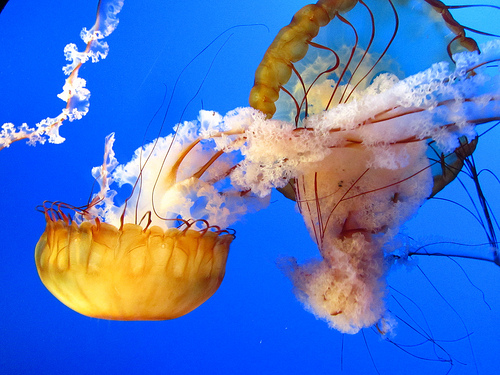By Dessa Bayrock (The Cascade) – Email
Print Edition: June 5, 2013
How much of a difference can 1.89 degrees Fahrenheit make?
It might not seem like a lot, but a slight warming of the ocean’s temperature is one of the factors resulting in millions of more jellyfish.
The term “jellyfish invasion” was coined last spring, as Japan fishermen found their nets clogged with jellies rather than the expected fish crop. The particular species they were running into problems with—Nomura’s jellyfish—can grow up to eight feet across. Groups—or smacks—can number in the millions, wreaking havoc to fishermen, boats and nets, as well as to the fish themselves. When jellies are caught by the same nets intended for salmon, the fish end up crushed, stung and covered in jellyfish slime – ultimately killing the fish and rendering an entire catch worthless.
Jellyfish are an ancient species; fossils place remarkably similar jellyfish in the oceans over 500 million years ago. If jellies have been a sea life staple for so long, what could be causing their population to explode in the last decade?
Researchers speculate that the jellyfish population boom is thanks in part to a slightly warmer ocean, but could also be a result of over-fishing. With less fish and sea turtles swimming around than, say, 40 years ago, smacks of jellyfish can grow to unprecedented sizes.
On the other hand, a study released by the Proceedings of the National Academy of Sciences is quick to point out that researchers have only recently started paying attention to jellyfish populations. It’s possible that this recent jellyfish invasion is part of a larger pattern – and that the current population of jellies is still within its normal range (albeit on the high end of normal). The question, then, is whether jellyfish populations have increased for good, or whether we’re simply in a high-population period of a cycle.
No matter what caused the increase, higher numbers of jellyfish are intimidating to say the least. A Google search quickly turns up photos depicting fishing nets and swimming holes clogged with giant jellies gathered into blooms of tentacles and squishy flesh. Jellyfish sting over 10,000 people each year, and roughly 40 people die from the stings of more poisonous species; this makes jellyfish three times more deadly than sharks. Some jellyfish even retain stinging abilities after death, meaning that a portion of jelly-related injuries each year stem from zombie jellyfish and disembodied tentacles.
But somehow these frightening aspects melt away when jellies are safely encased in an aquarium. The Vancouver Aquarium currently has a jellyfish exhibit on display ranging from tiny moon jellies to the sunset hues of the Japanese sea nettles. The invertebrates are a weird combination of relaxed and purposeful; they don’t seem dangerous so much as brainlessly contented to follow the clockwise current in their tanks.


